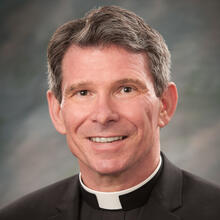A Reflection for the Thirty-third Sunday in Ordinary Time
Readings: Malachi 3:19-20a 2 Thessalonians 3:7-12 Luke 21:56-19
A tactical nuclear weapon is deployed in Ukraine. Its strategic consequences on the battlefield are limited. Indeed, the immediate carnage is small compared to the uncontrolled flight of population in its aftermath. The borders of the European Union collapse under the onslaught, and all of Europe is drawn into battle. Maybe Armageddon is avoided, maybe not. If not, life on earth as we have known it ends.
The theological issue, our concern, is this: Did the end of time come? Would this be “the second coming of Christ,” the moment he himself told us to expect?
To answer that question, begin by noting the secular use of the biblical term “Armageddon.” The Book of Revelation does speak of a final battle between the forces of good and evil (16:16), but it is only in the atomic age that we have come to use the word “Armageddon” for a final agony wrought by humanity itself.
Would a possibly imminent nuclear Armageddon be the second coming of Christ?
Previous generations imagined the sort of fire a nuclear conflagration would produce, but they did not identify the use of their own armaments with this annihilation. Their means of destruction were simply too paltry. As they saw it, their actions would be the formal cause of their undoing: They had merited punishment for their sins. But these deeds would not be the efficient cause because humanity was not yet capable of destroying all of life itself.
Linking the reason for our world’s destruction with our modern means is a new phenomenon. Unlike our forebears, we now think that we understand how Armageddon could occur. It need not be brought about through an extraordinary intervention on the part of heaven.
And to be fair, our forebears in the faith never read the Book of Revelation or other biblical prophecies as many contemporary believers do. The fathers of the early church were Platonists. They saw sacred Scripture as a skein of symbols, demanding prayerful pondering and perception. Biblical literalism, the belief that the meaning of Scripture is immediately evident to everyone, is a modern phenomenon.
We cannot simply identify a post-apocalyptic world—our secular use of a biblical term—with the reign of Christ.
Back to the question. Would a possibly imminent nuclear Armageddon be the second coming of Christ?
Hard to say. The planet would remain. There are not enough nukes to remove it from space. Out there, whether observed from the moon or the edge of our galaxy—to say nothing of the vast reaches of space beyond—nothing would have fundamentally altered.
If the cosmos continued, could we speak of our Armageddon as being the end of history? Yes, it would be that. Whatever might still live on earth would collapse back into a prehistoric age, a time when humans did nothing that needed to be noted as history. Nothing they did altered their future on the planet. That stasis would return, and what we call history would have been only a brief interlude between two vast silences of earth.
So, no. We cannot simply identify a post-apocalyptic world—our secular use of a biblical term—with the reign of Christ. There is nothing to preclude that God might determine that ages should pass and that a new human species should arise, though that raises the interesting question of how this new humanity would encounter God’s own revelation of self in Jesus Christ. Archaeology?
Will Christ manifest himself and end history? Assuredly yes, if you believe in him and what he said. When will this happen and how? Even in this atomic age, we still do not know.
What ultimately constitutes the second coming of Christ is his definitive manifestation as Lord. A moment when he is no longer accessed through faith. Instead, Christ’s presence would so imbue existence that our relationship to him would stand fully revealed. Faith would no longer be needed to know that he is the meaning of existence. That would be self-evident.
What is truly fascinating is the way in which God has constructed the act of faith to foreshadow its own completion. At the end of time, Christ will be self-evident. But as we live in time, we have faith in Christ because we have encountered him. He has undeniably, at least for us, manifested himself to us. The difference between our current acts of faith and the end of history is one of measure, not kind. Faith is a confidence of the heart. The apocalypse is a conviction wrought in history. In both, Christ is self-evident, first to an individual and then to all.
Will Christ manifest himself and end history? Assuredly yes, if you believe in him and what he said. When will this happen and how? Even in this atomic age, we still do not know.
Whatever might happen on earth, there is a heavenly component that must come into play, just as there was in the Incarnation. God chose to enter our history and to claim it. God chooses the moment of the Apocalypse—unveiling in the Greek—when history is consummated, brought to completion in Christ. In both instances, Incarnation and Apocalypse, the God who created our world to stand free in its own, proper existence lifts it into divine life, reveals it as ordered to a completion outside its own act of existence.
We have every reason to fear what might happen in Ukraine or Taiwan or some unsuspected place through an act of terrorism. It might indeed be the end of life as we know it. But we have no reason to fear the second coming because at that point, whatever we will have made of the planet and its life, Christ will clearly manifest himself as our necessary and, at least for some, glorious and joyful completion.








